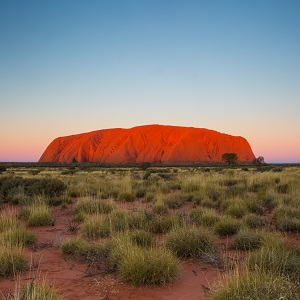Uluru is the most recognisable natural landmark in Australia’s Red Centre.
It is one of the must-see attractions in the world, millions of years old with deeply spiritual importance to the Indigenous community of Australia. Thousands of visitors come to this stunning geological formation year-round, crowding the red sand that surrounds it. But what time is best when visiting Uluru?
-
May to September
This is typically the best period of time in the year to visit Uluru. The climate in the months of May to September is usually on the cooler side, being much more bearable when visitors trek, camp, and drive to Uluru. The colours of the rock are also known to be more vibrant during this period and can give your photos an even better contrast when snapping shots at sunrise or sunset.
-
December, January, February
By far the most challenging time to travel to Uluru is during the summertime! The extreme weather involves scorching heat during the day that reaches temperatures up more than 40 degrees. The highest temperature recorded was a top of 45.5 Celsius degrees – which was only in the shade. Usually, temperatures around this time average around the mid-30s, which is still extremely hot! The trek walks to Uluru can be extremely challenging in this time, particularly for those not used to a hotter climate.
-
June to September
Australia’s winter months are known for being the busiest time for travellers, with predominantly US and Europeans visitors flooding the region. Due to the popularity of this time, the prices peak, with flights, accommodation, tours, and more all skyrocketing. The crowds gathered at sunrise and sunset can be overwhelming and can sometimes spoil the effect of Uluru during this time. For this reason, travelling in the alternative holiday periods to the US can be better, with Aussie holiday times a lot less packed.
When should you visit Uluru, once there?
Sunset and Sunrise
Famed for being the best time to visit Uluru, the sunset and sunrise both offer a unique experience at this rock formation. Each time the sun moves to or from the horizon, the colours of Uluru enhance greatly, with the dust particles and water vapour in the atmosphere acting as a filter, which removes the blue light from the incoming sun rays. This allows the red light to stream into the area and reflect against the rock, giving Uluru a spectacular red glow which contrasts beautifully with the surrounding region. If you visit at sunrise, you can start your day with a bang, with the dark region slowly coming to life again with the brilliant sun glow. At sunset, visitors can sit back with a glass of sparkling and enjoy a sunset dinner nearby, with tables that give you one of the best dining experiences of your life.
Related article: Why you should visit Uluru-Kata Tjuta National Park Cultural Centre
Explore the Uluru Tours
-
ULURU SACRED SITES & SUNSET
Available Now!
Tour Type: LuxuryAdult:$195.00
🔥 🔥 🔥 🔥 🔥 Child:$139.00
🔥 🔥 🔥 🔥 🔥Book Now
More Info
-
ULURU SUNRISE & KATA TJUTA
Available Now!
Tour Type: LuxuryAdult:$199.00
🔥 🔥 🔥 🔥 🔥 Child:$199.00
🔥 🔥 🔥 🔥 🔥Book Now
More Info




